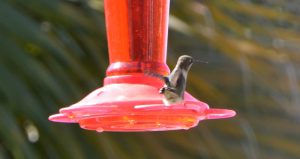By Les Harrison
Tale Of The Ant And The Grasshopper
Aesop, the Greek fabulist, told the moralistic tale of the ant and the grasshopper more than 2500 years ago. The ant was wisely industrious and prepared for the coming winter, but the grasshopper was profligate and procrastinated, not stocking up for the impending period of privation.
It did not end well for the decadent grasshopper. The take-home message of the story was to be prepared and have reserves ready because days-of-plenty are limited.
The autumnal equinox occurs soon and the northern hemisphere officially enters the fall season, at least on the calendar and at the equator. Here in panhandle Florida at approximately 30 degrees north latitude the night will be a minute longer than the day beginning on September 26.
Days-Of-Plenty Are Limited For Insects, Birds And Animals
Either way, the insects, birds and animals have received the message that the good times of 2018 are about to end. Even the grasshoppers have gotten the idea and are eating any palatable foliage within easy reach.
Social insect, such as European Honeybees, are working hard collecting nectar and pollen from the early autumn wildflowers. Goldenrods, partridge peas and many others are humming with activity as the bees build up their stores.
Honeybees also have another tactic for surviving the adversity of winter. The worker bees, which are all females, eject the drones, which are all males, from the hive.
The drones scatter and are left to their fate. They cannot forage and feed themselves, so they starve or fall victim to a hungry bird or animal.
Even in winter the queen honeybee continues to produce replacement in the form of viable brood. Enough males will hatch in the spring, and the process will begin again.

Shortening Days Of Autumn For Monarchs
Many butterflies and moths drink the nectar of late blooming plants during the shortening days of autumn. Some, like the monarchs, are preparing for the arduous migrations to sunny south-of-the-border locations.
Zebra longwings feast on the pollen of late bloomers as a method of producing a bad taste to repulse predators. Other butterflies, like the buckeye, remain in north Florida and have enough surviving members to replenish the populating in the spring.
Humming Birds, Darting From Bloom To Bloom
Humming birds currently are darting from bloom to bloom drinking the nectar to support their quick paced lives with this high carbohydrate solution. Like the monarch butterflies, they will soon depart on a southerly heading.
The tiny hyperactive birds which have a typical wing beat of 50 per second and a heart rate of 1250 beats per minute need the calories. Their supersonic metabolism demands the stratospheric energy levels provided by local autumn wildflowers so these tiny avian visitors can successfully complete their 500 mile trip across the Gulf of Mexico.
Grasshopper’s Cousin, The Katydid
Even the lazy and long maligned fabled grasshopper’s cousin, the katydid, is enjoying the remaining warm days by snacking on available blooms. This member of the Tettigoniidae family is an indiscriminant eater much like the grasshopper, but late season flowers are definitely on the menu.
Katydids are most easily distinguished from grasshoppers by their long antennae which extend beyond the length of the insects body. Unlike Aesop’s grasshopper, most species are not wasting a minute preparing for winter.
To learn more about autumn in north Florida, contact the local UF/IFAS County Extension Office. Click here for contact information.
 0
0

